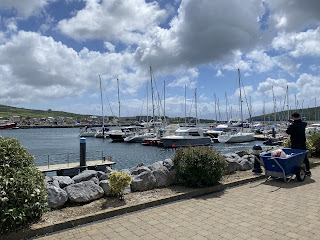I just realized tonight that my earlier titles of just listing the city may not be entirely helpful. So, I’m making sure that I also add the country and/or region, if important. I had scheduled to go on an EcoTour to Blanket Island, off the coast of Dingle, to see the breeding grounds of a sizable colony of Atlantic Puffins (a bucket list item), and a large herd of seals as well as some other natural wildlife - dolphins/whales/other birds, etc... Although the day looked absolutely beautiful in the morning with sunny skies (a highly unlikely event in Ireland), by the time I took the 2 1/2 hour local bus ride up to Dingle, I found out that the winds were too strong and that they had canceled all trips out to the island until Saturday. Instead I took a harbor tour, where the winds created considerably less danger. I took a short video of the “calmer harbor waves”. Hopefully, I’ll be able to upload it. We were told that the waves were 5-6 times larger out in the Atlantic and that their boats just weren’t large enough to take out safely. Before I got on the bus to Dingle, I stopped at St Mary’s Church, a Church of Ireland.
Most of the churches in Ireland are either part of the Roman Catholic Church or are part of the Church of Ireland. What’s the difference? The Church of Ireland is part of the Anglican Communion, although it is not Anglican itself. The Church of Ireland also did not come out of the time of Reformation of the Catholic Church although it calls itself reformed, instead it has its origins in the early Celtic Church of St Patrick, which dates back to the 5th Century. It’s not Catholic, having developed separately from the Roman Catholic faith, but it is also not a church that grew out of the Reformation, although it considers itself both reformed and part of the Anglican community. I hope that makes it as clear as mud, but that’s about the best way I can describe it. Anyway, here are pictures from inside St Mary’s Church - a Church of Ireland. Oh, and by the way, it seems that nearly ALL churches in Ireland are called St Mary’s! I’ve already seen six!










For those of you who read my blog on Spain/Portugal, might remember that I felt my sister’s presence in a strange place called, Cordoba. It wasn’t until my tour guide kept pointing out numerous peacocks everywhere in the city that I figured it out. My sister loved peacocks. And my tour guide explained that they symbolized eternity. My sister and I were not biologically related. She was part Irish and we always lovingly teased her about her quick wit and temper (typical traits of the Irish!) On the Communion Table at St Mary’s was this parament.
Here are my pictures from the Harbor Tour in Dingle:
The Dingle Lighthouse was completed in 1887 after the destruction of part of the primitive three towers that had been erected during the Great Famine/Hunger (or as we usually refer to it - The Irish Potato Famine).
At the top of the hill you can just make out tower 1 of the three primitive towers that directed ships into the harbor. They were completed during the Great Hunger under the direction of the local minister who wanted to give the people a purpose in the midst of great despair. During the years between 1845-1849, a quarter of the entire population of Ireland either died or left Ireland.
You can just barely make out the remains of tower 2 at the top of the outcropping in the middle of this photo, which had been painted white when it was built. It crumbled from the constant battering of the winds and waves at the opening of the harbor. Tower 3 on the opposite side of the opening no longer exists, at all.
This tower was built by the Normans who conquered the area in the 12th/13th Century and was perhaps to be part of a fort that was never built.
The large home below is now a Boarding School for girls, but was the home of the Fitzgerald family who were the wealthiest inhabitants of the town of Dingle in the mid 18th to 19th Century, making their fortune in importing flax seed and linen. Unfortunately, the industrial revolution made the production of cotton in Great Britain much faster and cheaper. The family became nearly bankrupt by 1837.
Here’s the video of the calmer waves in today’s harbor.





































































No comments:
Post a Comment